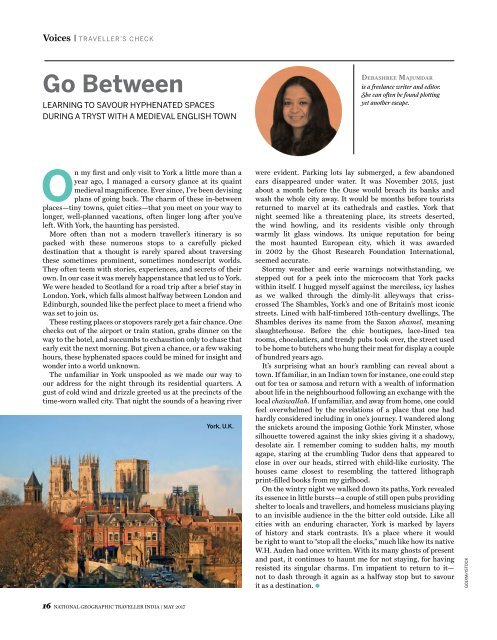National_Geographic_Traveller_India_May_2017
You also want an ePaper? Increase the reach of your titles
YUMPU automatically turns print PDFs into web optimized ePapers that Google loves.
Voices | TRAVELLER’S CHECK<br />
Go Between<br />
LEARNING TO SAVOUR HYPHENATED SPACES<br />
DURING A TRYST WITH A MEDIEVAL ENGLISH TOWN<br />
Debashree MajuMDar<br />
is a freelance writer and editor.<br />
She can often be found plotting<br />
yet another escape.<br />
On my first and only visit to York a little more than a<br />
year ago, I managed a cursory glance at its quaint<br />
medieval magnificence. Ever since, I’ve been devising<br />
plans of going back. The charm of these in-between<br />
places—tiny towns, quiet cities—that you meet on your way to<br />
longer, well-planned vacations, often linger long after you’ve<br />
left. With York, the haunting has persisted.<br />
More often than not a modern traveller’s itinerary is so<br />
packed with these numerous stops to a carefully picked<br />
destination that a thought is rarely spared about traversing<br />
these sometimes prominent, sometimes nondescript worlds.<br />
They often teem with stories, experiences, and secrets of their<br />
own. In our case it was merely happenstance that led us to York.<br />
We were headed to Scotland for a road trip after a brief stay in<br />
London. York, which falls almost halfway between London and<br />
Edinburgh, sounded like the perfect place to meet a friend who<br />
was set to join us.<br />
These resting places or stopovers rarely get a fair chance. One<br />
checks out of the airport or train station, grabs dinner on the<br />
way to the hotel, and succumbs to exhaustion only to chase that<br />
early exit the next morning. But given a chance, or a few waking<br />
hours, these hyphenated spaces could be mined for insight and<br />
wonder into a world unknown.<br />
The unfamiliar in York unspooled as we made our way to<br />
our address for the night through its residential quarters. A<br />
gust of cold wind and drizzle greeted us at the precincts of the<br />
time-worn walled city. That night the sounds of a heaving river<br />
York, U.K.<br />
were evident. Parking lots lay submerged, a few abandoned<br />
cars disappeared under water. It was November 2015, just<br />
about a month before the Ouse would breach its banks and<br />
wash the whole city away. It would be months before tourists<br />
returned to marvel at its cathedrals and castles. York that<br />
night seemed like a threatening place, its streets deserted,<br />
the wind howling, and its residents visible only through<br />
warmly lit glass windows. Its unique reputation for being<br />
the most haunted European city, which it was awarded<br />
in 2002 by the Ghost Research Foundation International,<br />
seemed accurate.<br />
Stormy weather and eerie warnings notwithstanding, we<br />
stepped out for a peek into the microcosm that York packs<br />
within itself. I hugged myself against the merciless, icy lashes<br />
as we walked through the dimly-lit alleyways that crisscrossed<br />
The Shambles, York’s and one of Britain’s most iconic<br />
streets. Lined with half-timbered 15th-century dwellings, The<br />
Shambles derives its name from the Saxon shamel, meaning<br />
slaughterhouse. Before the chic boutiques, lace-lined tea<br />
rooms, chocolatiers, and trendy pubs took over, the street used<br />
to be home to butchers who hung their meat for display a couple<br />
of hundred years ago.<br />
It’s surprising what an hour’s rambling can reveal about a<br />
town. If familiar, in an <strong>India</strong>n town for instance, one could step<br />
out for tea or samosa and return with a wealth of information<br />
about life in the neighbourhood following an exchange with the<br />
local chaiwallah. If unfamiliar, and away from home, one could<br />
feel overwhelmed by the revelations of a place that one had<br />
hardly considered including in one’s journey. I wandered along<br />
the snickets around the imposing Gothic York Minster, whose<br />
silhouette towered against the inky skies giving it a shadowy,<br />
desolate air. I remember coming to sudden halts, my mouth<br />
agape, staring at the crumbling Tudor dens that appeared to<br />
close in over our heads, stirred with child-like curiosity. The<br />
houses came closest to resembling the tattered lithograph<br />
print-filled books from my girlhood.<br />
On the wintry night we walked down its paths, York revealed<br />
its essence in little bursts—a couple of still open pubs providing<br />
shelter to locals and travellers, and homeless musicians playing<br />
to an invisible audience in the the bitter cold outside. Like all<br />
cities with an enduring character, York is marked by layers<br />
of history and stark contrasts. It’s a place where it would<br />
be right to want to “stop all the clocks,” much like how its native<br />
W.H. Auden had once written. With its many ghosts of present<br />
and past, it continues to haunt me for not staying, for having<br />
resisted its singular charms. I’m impatient to return to it—<br />
not to dash through it again as a halfway stop but to savour<br />
it as a destination.<br />
G01XM/ISTOCK<br />
16 NATIONAL GEOGRAPHIC TRAVELLER INDIA | MAY <strong>2017</strong>


















